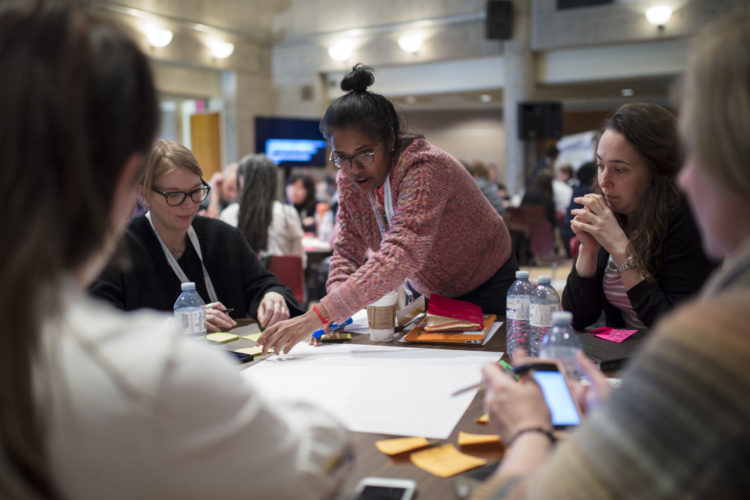
Ontario Digital Inclusion Summit – Summary Report
Introduction
In February 2018, the Public Policy Forum (PPF) and the Government of Ontario joined forces to host Ontario’s first Digital Inclusion Summit to discuss digital inclusion, share knowledge, and identify key policy and research opportunities. The Summit also shaped a common understanding of digital inclusion and will, we hope, launch multi-sectoral collaborations.
The Summit was held on Friday, February 9 and Saturday, February 10. A weekend day was included to ensure that people interested in issues related to digital inclusion but not working in the field would be able to contribute to the conversation.
Each day had distinct goals. On February 9, an overview of digital inclusion created a shared understanding of the topic. The day featured a series of keynotes which were complemented by short presentations given by practitioners in the field. The presentations were chosen through a call for proposals which received more than 60 submissions from the public, private, academic and non-profit/community sectors.
On February 10, participants shared their knowledge about digital inclusion, participating in facilitated conversations and activities in small groups. There were three sessions on digital inclusion across dimensions, across sectors and across domains. Each breakout session was preceded by two lightning talks by practitioners, again drawn from the call for proposals.
This report provides a summary of the content covered during the Summit. Full recordings of the event are also available on the event recap page.
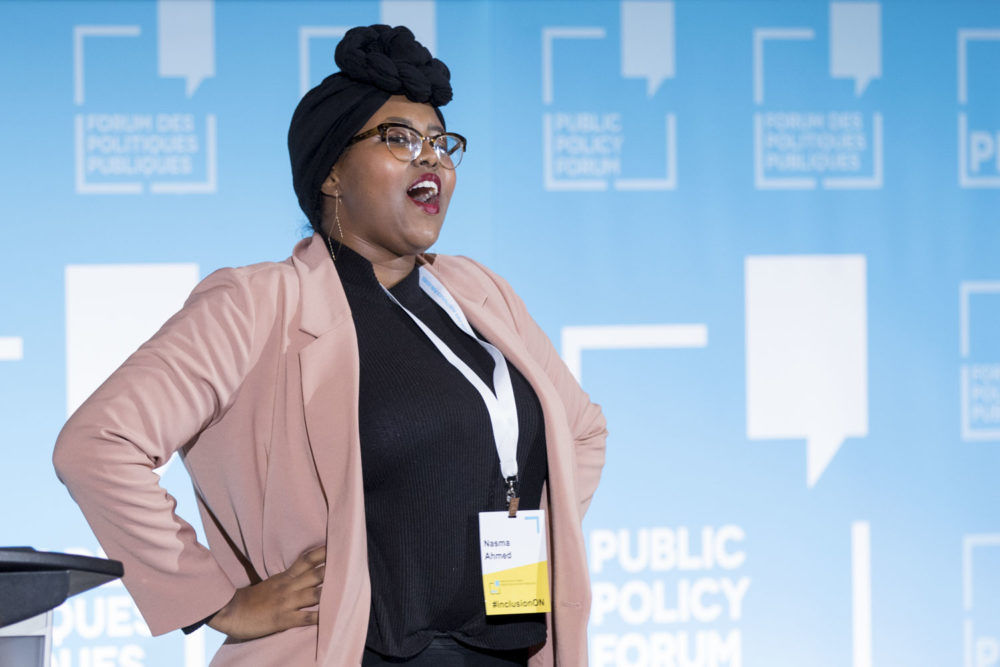
Our lives increasingly take place online, from how we engage with our communities, to how we apply for government services, to how we launch small businesses. Yet not everyone enjoys the myriad economic, social, health, educational and cultural benefits of digital technologies. This is caused by a lack of access to the digital world, limited digital literacy and many other factors. Rather than one digital divide there are many divides which are related to income, geography, literacy, comfort, culture, demographics and more.
So what is digital inclusion? The Government of Ontario defines it as: “the aim of interventions which seek to increase access, remove barriers, develop skills and empower people who might be otherwise marginalized and excluded from the design and use of digital technologies.” Digital inclusion aims to “ensure that everyone can benefit from digital technologies in their lives.”[1]
According to the National Digital Inclusion Alliance (NDIA), if digital equity is the what, digital inclusion is the how. The NDIA (based in the United States) defines digital inclusion as:
… the activities necessary to ensure that all individuals and communities, including the most disadvantaged, have access to and use of Information and Communication Technologies (ICTs). This includes 5 elements: 1) affordable, robust broadband internet service; 2) internet-enabled devices that meet the needs of the user; 3) access to digital literacy training; 4) quality technical support; and 5) applications and online content designed to enable and encourage self-sufficiency, participation, and collaboration. Digital Inclusion must evolve as technology advances. Digital Inclusion requires intentional strategies and investments to reduce and eliminate historical, institutional and structural barriers to access and use technology.[2]
The design of the Ontario Digital Inclusion Summit was based on a framework from the Institute of Museum and Library Services. This framework is composed of the key pillars: access, adoption and application. For people to benefit from digital technologies, their needs must be met across each of the three pillars: they must have sufficient access (access), the means for safe uptake and effective use (adoption), and the opportunity to apply relevant digital technologies in their lives (application).
Day 1: Barriers to digital inclusion
Day one focused on the barriers to digital inclusion faced by individuals. Speakers and participants shared their experiences and the ways in which digital divides impacted them and their communities.
Eleanor McMahon, Ontario’s Minister Responsible for Digital Government
Minister McMahon opened the summit by establishing the benefits of access to the digital world. Access to broadband not only improves economic opportunities for individuals, but also improves competitiveness and quality of life for all Ontarians. Yet not everyone is benefitting from the digital revolution. While 98 percent of Ontario households are in areas served by at least basic broadband, only 62 percent of low-income households have a connection at home. Access to the internet in public spaces such as libraries is important, but for true accessibility people must have access from home.
The minister announced the launch of a Digital Literacy and Coding Pilot in partnership with the Brookfield Institute. This pilot project is developing and testing new models to teach digital literacy and coding skills to 12 to 15-year-old youth from groups which are underrepresented in science, technology, engineering and mathematics (STEM). Minister McMahon also said that the Summit was a part of a global dialogue about whose needs are met by technology, who designs it and who benefits from it. We must have an honest conversation about this if we are to leave no one behind.
The minister asked Summit participants three questions about the path towards a more digitally inclusive Ontario:
- What gaps, barriers and challenges need to be overcome in order to ensure that everyone in Ontario can benefit from digital technologies in their lives?
- How might we build capacity and empower people in the design, creation and use of digital technologies to address challenges they are facing in their communities?
- How should government work with the private sector, non-profits, civil society, academia and others to help achieve digital inclusion in Ontario?
Hillary Hartley, Chief Digital Officer and Deputy Minister, Digital Government
Deputy Minister Hartley confronted the elephant in the room: not everyone is getting ahead. Many divides persist in this digital age with geography, age and gender impacting access and use. The impact of digital disruption is yet to be fully understood and therefore we don’t have an accurate picture of the extent of the exclusion—we are only beginning to address these barriers and ask the right questions. Hartley also emphasized the importance of testing assumptions and understanding the needs of the user, whether in the design of a product or a service.
“We believe in designing for the edges because everyone is part of those edges.” Hillary Hartley
Hartley also expanded on the three pillars of Ontario’s draft digital inclusion framework, explaining how we might assess the needs of communities across each of the pillars:
- Access (availability, affordability, inclusive design, public access): Do people have access to fast, reliable, affordable internet across Ontario? Are digital technologies inclusively designed, so that everyone can use them? Are public access options available for people without home access?
- Adoption (uptake and relevance, digital literacy, safety, privacy & data rights): Do people have the knowledge and skills to access and use technology? Are these tools being built and considered in the most effective ways? Are people able to maintain their privacy and be safe online?
- Application (education, employment, economic development, health, social inclusion, cultural expression, civic engagement, public safety): Whose needs are served by available technologies, who benefits and who does not? Can people, communities, and businesses improve their outcomes through the use of technology?
Angela Siefer, Executive Director, National Digital Inclusion Alliance (NDIA)
Siefer has worked on issues related to digital inclusion since 1997. She began by examining how non-profits used technology to engage with their constituents which led her to run a community computing network. Now with the NDIA, which operates in the United States, Siefer and her team has created a definition of digital equity and digital inclusion; according to their framework, digital inclusion is the activity—such as affordable broadband, digital literacy and access to devices—to achieve digital equity.
According to Siefer, broadband infrastructure is heavily dependent on investment from the private sector which means that if there isn’t a profit to be made, certain communities, often low-income neighbourhoods, will simply not be served. On the other hand, governments cannot solve this issue on their own; they must partner with the private sector and non-profit organizations. Indicators to measure digital equity and inclusion are also key to making progress.
“The more I do this work the more I’m convinced it will never end – there will always be another divide that we need to tackle” Angela Siefer
Alexander Dirksen, Manager, Strategy and Engagement, First Nations Technology Council
Alexander Dirksen of the First Nations Technology Council spoke of the need for digital reconciliation and digital equity. Dirksen described the barriers, prejudices and stereotypes in the analog world that have the potential to be recreated in our digital environment. Connectivity was recently recognized as a basic right by the CRTC, yet many Indigenous communities have low connectivity and poor internet speeds. Despite the barriers, Indigenous groups are finding novel ways to use technology, such as in the use of Geographic Information System mapping for land claims or social media to organize Idle No More.
Alexander reminded participants that representation matters. As in many other industries, there are few Indigenous leaders in technology. More can also be done to fund Indigenous leadership initiatives such as the Northern Indigenous Community Satellite Network which connects communities in northern Québec, Ontario and Manitoba. Young Indigenous graduates must also receive opportunities to receive digital skills and literacy training. And why shouldn’t we expect Siri to speak Ojibway or Cree?
Ultimately, we must recognize that we all have a role to play in reconciliation, whether it be through cultural competency training or by educating ourselves and our children.
Beyond a Computer and a Connection: The Need for Digital Literacy
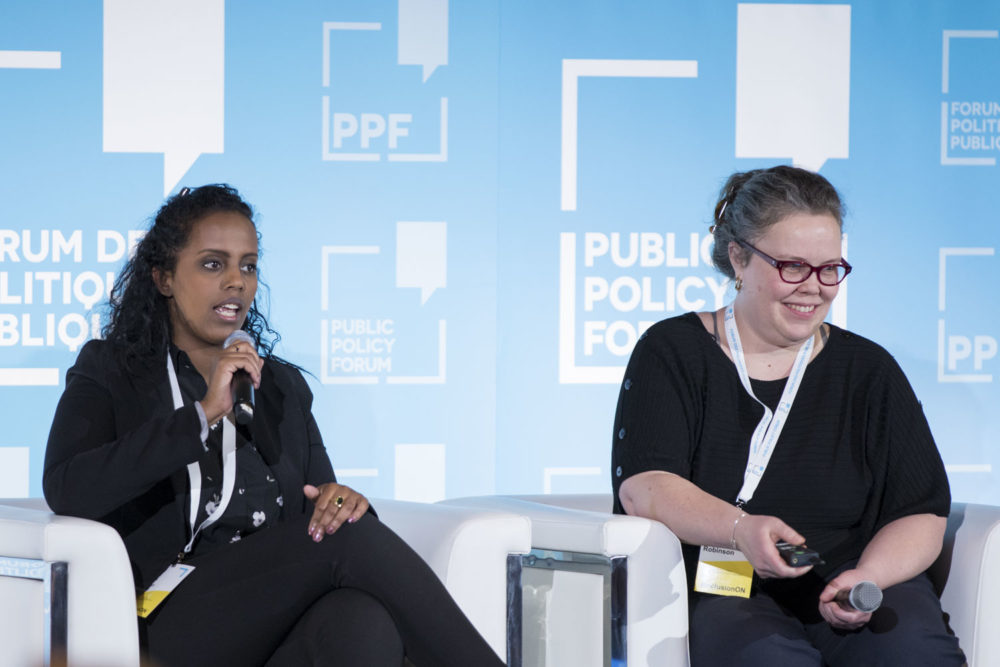
Although both their organizations, CompuCorps and National Capital Freenet, performed work related to access to infrastructure, Zeina Osman and Shelley Robinson soon realized this was not to ensure access to online spaces. Both organizations started working with groups from youth to seniors who expressed interest in gaining digital skills. We also need organizations in Canada similar to the NDIA to connect the dots between organizations and people and to champion digital inclusion.
Inclusive Accessibility as an Economic Opportunity
David Best from the Alliance for Equality of Blind Canadians described three barriers faced by people with vision loss: attitudes, standards and engagement. Attitudes are the biggest barrier. People with vision loss have an unemployment rate of almost 80 percent, in part because policies fund employers to buy assistive technologies and training rather than supporting people directly. This process has not adapted to the changing nature of work, in which people have multiple employers in a lifetime or are self-employed.
Additionally, standards and regulations are interpreted by designers based on their perception rather than the lived experiences of those with vision loss. Finally, access to real-time information is often lacking. To remove these barriers, Best suggested three steps: shifting our attitudes from colonialism to ‘multicultural modernism’; becoming more accountable for implementing and enforcing accessible digital design for all communications channels; and providing direct support for people with vision loss.
“Access means engagement. If we cannot be engaged, we cannot participate. (…) Open and transparent processes are not necessarily inclusive.” David Best
Nasma Ahmed, Open Web Fellow, Ford-Mozilla
Ahmed is an Open Web Fellow working at the intersection of technology and social justice and issues related to privacy and surveillance. Certain communities are more greatly impacted by surveillance, which can be amplified in this digital era. What stops certain communities from engaging online may not necessarily be a lack of access and infrastructure but rather power, privilege and concerns related to being surveilled. If we are not careful, we could repeat structural inequities online rather than building new models of community to empower a different type of digital future.
According to Ahmed, the current discussion about digital inclusion is very integrationalist and that we are not thinking of the hazards which accompany this. Corporations currently have most of the power. Open source data and platforms can rebalance the power dynamic. Citizens should educate themselves but governments and non-profits have important roles to play.
“To really transform our society we will need to make justice one of the most pleasurable experiences we will have.” Nasma Ahmed
Insights into Inclusion II
Older Canadians and the Digital Divide
Two million Canadians aged 65 and older are not connected or participating online. As with most other groups, seniors that are more educated and have higher incomes are more likely to use the internet. According to Ryerson Professor and CRTC fellow Catherine Middleton, we will always need to accommodate diverse needs–some people will never want to go online or may not use apps. Seniors’ main online activities are email, reading news and using some social media; very few do their banking or shopping online. People tend to stay with the technology they are comfortable with throughout their lives. For many seniors, a simple and clear website is the way to reach them. Digital interfaces are not one size fits all; we need to think in multiplicities when developing programs, services and interfaces.
Bridge: Technology Assessment Toolkit: Closing the Gap on Technology Access & Inclusion
Carmen Ho and Elizabeth Glass presented the digital inclusion work of the Toronto Public Library and the network of libraries across Ontario. According to Ho and Glass, no other public institution has the mandate and reach to provide digital inclusion and digital literacy training. For many, the library is not only their main access to the internet but it is also where they learn digital skills. Therefore, the library also sees privacy as a key pillar of their work to ensure that users understand how their information is being shared and used.
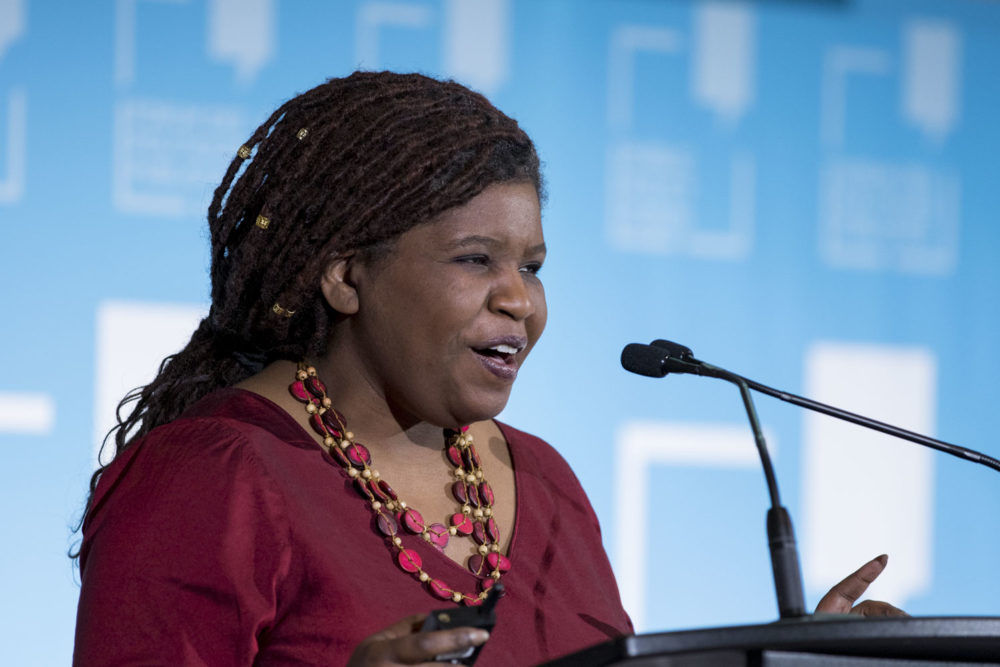
Libraries are digital innovation hubs and they are creating spaces where people can find their voice. Some innovative programming includes the Open Data Bookclub which the library engages to ensure that the data they collect is useful and to identify gaps in the available data. In 2017 alone, libraries across Ontario gave 150,000 public classes.
Dr. Dori Tunstall, Dean, Faculty of Design, OCAD
According to Dr. Dori Tunstall, respectful design accepts multiple perspectives, presents a shared understanding of multiplicity and creates spaces where everyone belongs. For design to be respectful, we must all confront our own prejudices and biases in the work we do, and we must not require individuals to be experts to participate; rather, individuals should be recognized as experts of their own experiences.
Using digital technology, artists at OCAD push boundaries and confront stereotypes that demonstrate how non-inclusive society can be. The Inclusive Design Research Centre develops tools, processes and technologies that seek to meet the user needs on an individual basis. OCAD has also made decolonization its first priority to redress the exclusion of Indigenous people–without this, no other inclusion work can succeed.
How do I adapt what the user needs and wants to the specificity of their complex identities so they feel they can use the product?” Dr. Dori Tunstall
Insights into Inclusion III
Public Sector Legal Information: The Potential of Inclusive Design & Open Access
What does government owe its citizens? asks Avery Au. Legal information should be accessible to all citizens. Yet this information is rarely publicly available and when it is, it is rarely user-friendly, especially for those without a legal background. Barriers include difficult navigation, information being presented in technical language, and an absence of complementary information that would render it meaningful. These barriers prevent groups from accessing and using legal information to assert their rights. Au advocates for inclusive design in the context of public legal information, in order to improve access to justice.
Advancing Women Leaders in Technology
Technology companies face challenges in recruiting talent. At the same time, there are few women leaders in the industry, and even fewer women of colour. Dayana Cadet and Jessica Yamoah described the “tug of war” through women which are led to believe there is only space for one woman in leadership, leading them to compete against each other. To remedy this, initiatives like Move the Dial work to drive awareness, inspire action and create a community of mentors for women in the industry, with a particular emphasis on ensuring the experiences of women of colour are represented and valued. Cadet and Yamoah issued four calls to action: drive awareness within your team; create goals and policies that promote diversity; inspire action amongst your peers; and, identify key women of colour within your industry and provide them with opportunities.
Final Panel: Closing Reflections
Pamela Robinson from Ryerson University and Kylie Havelock from Canadian Digital Services provided closing reflections.
- We all need to be accountable as leaders for our organizations and for our own cultural competency. We also need to be aware of our inherent biases.
- We must recognize and understand the difference between equity and equality.
- We should be planning and co-creating with communities, not for communities.
- Inclusiveness is not an add-on; it must be baked in from the outset of a project. We need relationships built on trust.
- We must have access to better data to understand the gaps and use evidence to do our work and craft policy.
- We can use economic arguments to make the case for inclusion–there is a return on investment when it comes to infrastructure, skills, and
- Governments can use spending as a mechanism to ensure accessibility. If the service is not accessible, you don’t get the funding.
- There is no one size fits all when it comes to inclusiveness.
- Funding and assets are needed to scale initiatives across the province and the country. Government support and private sector partnerships can expand this capacity.
- We all bring assets to the table. It’s about the puzzle pieces, the patchwork that we do.
Robinson and Havelock left the audience with two calls to action: to question whether we are willing to give up our seat at the table for some else, and to become experts in the practice of empathy.
On day two, participants were invited to take part in small group discussions led by a facilitator.[3] Over the course of the day, participants joined three different breakout sessions, self-selecting into the topic of most interest to them. Some tables were left open to give participants to opportunity to identify a topic that was not part of the list.
The goals of the breakout sessions were to:
- Give participants a chance to meet one another and identify potential common areas of interest
- Offer participants an opportunity to draw on their knowledge and experience
- Provide a way for participants to engage with other participants in a respectful, collaborative and constructive way
- Identify and capture both common and uncommon areas of opportunity and needs related to the topics
| Table topics of discussion | ||
| Breakout 1: Digital inclusion across dimensions | Breakout 2: Digital inclusion across sectors | Breakout 3: Digital inclusion across domains |
|
|
|
Each breakout session used a similar process and set of questions. Participants introduced themselves and their interest in the topic at hand. They shared at least one challenge or opportunity regarding digital inclusion and the topic being discussed. Participants then shared at least one idea or action that could be taken to address those challenges and opportunities. Facilitators captured the entire discussion.
All in all, this process led to more than 850 data points from approximately 100 participants on day two of the Summit.[4] The common themes and findings from the breakout sessions are synthesized below to share these insights with the wider community, in hope of contributing to the body of knowledge on digital inclusion in Ontario. These challenges, opportunities and ideas provide a foundation upon which wider conversations on digital inclusion can build.
Designing, Testing and Teaching Digital Literacy
Nisa Malli from the Brookfield Institute provided a historical overview of what we define as digital literacy and digital skills. These definitions have continuously evolved yet have remained ambiguous as the speed of technological change has increased. With every new operating system or new hardware, people with lower incomes and lower digital literacy skills are left behind. We need to get a better grasp of what these terms mean and how we evaluate programs. How can we collectively do a better job at benchmarking and evaluating progress?
Digital Inclusion Using Wireless Mobile Networks
Dan Gillis, an associate professor and statistician at the University of Guelph, works in Rigolet, Nunatsiavut, Labrador, where a group of researchers and community members are trying to collect and share data related to climate change and how it affects ice roads. Ice roads are used by communities to access traditional food sources. However, it is difficult to share this information in an area without cellular towers and internet. Through the development of a mobile mesh network, community members from across this vast geographical area can now connect to each other and share data by using personal devices that already exist within their communities.
Breakout #1: Digital inclusion across dimensions
In this breakout, participants explored the influence of socioeconomic status, gender and sexual identity, geography, ability and ethnocultural diversity on digital inclusion.
| Challenges and opportunities | Ideas and actions | |
| Geography
|
|
|
| Ethnocultural diversity
|
|
|
| Socioeconomic status
|
|
|
| Gender and sexual identity
|
|
|
| Ability
|
|
|
| Intersectionality and power (dimension identified by participants)
|
|
|
Transform the Sector: An Inclusive Approach to Planning Data Infrastructure
Jon McPhedran-Waitzer and Michael Lenczner of Powered by Data shared their experience of creating an inclusive approach to data infrastructure for administrative data. Administrative data is the data that government holds about citizens, and sharing of this data already occurs in Canada and in other jurisdictions. Powered by Data believed that we needed to discuss whether and how as a society we want to take advantage of this data. For this to be possible, it is necessary to identify the power dynamics present in our society and build relationships.
Inclusion in an Era of Open Dialogue and Digital Engagement
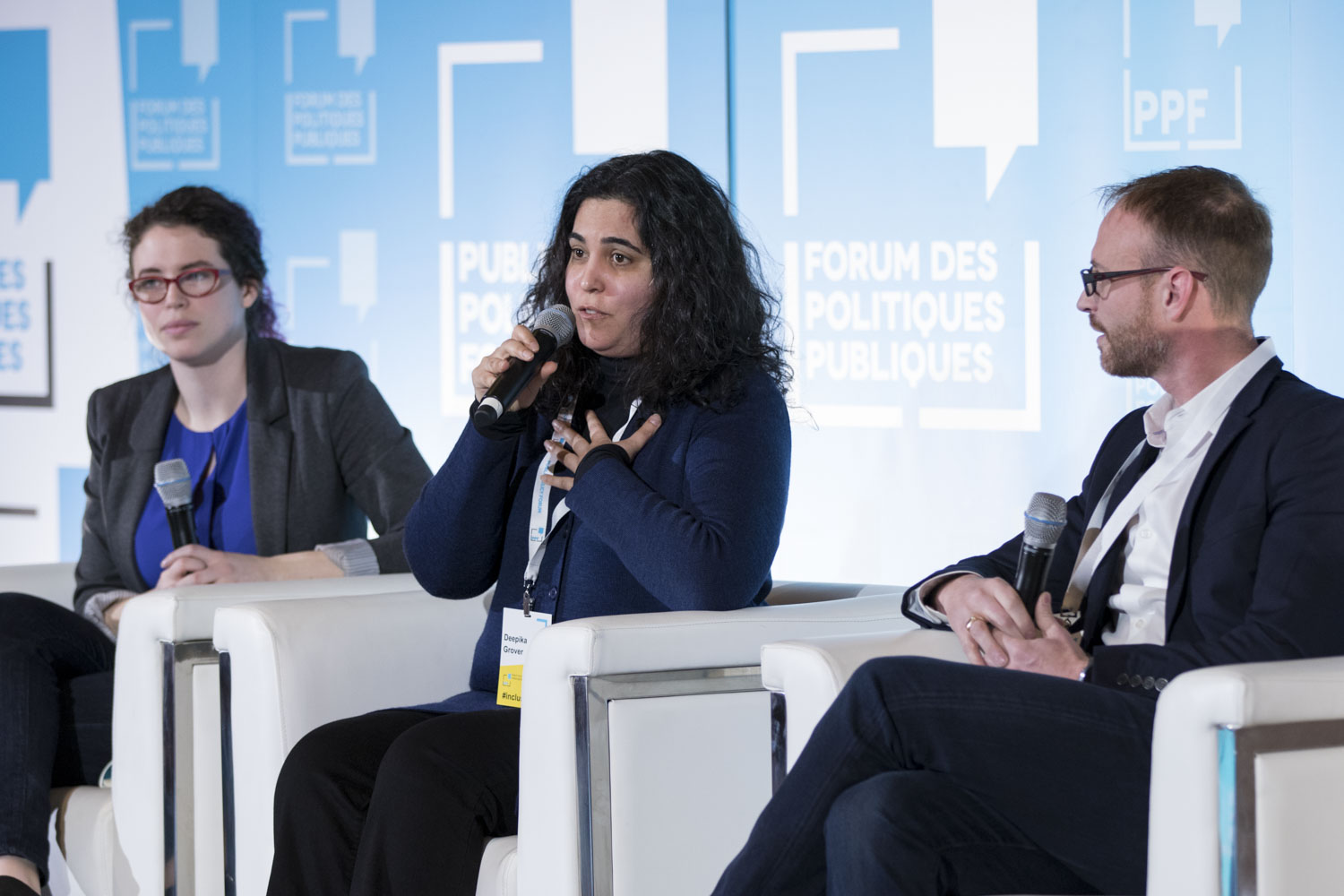
According to Deepika Grover and Cedric Jean-Marie from the Department of Canadian Heritage, governments are moving from traditional stakeholder engagement to more open policymaking where engagement is a continuous process. In the past, IT functions in government have been siloed from policymaking, which doesn’t make sense in a digital era. Canadian Heritage launched a visual arts marketplace engagement initiative to inform federal policymaking, acknowledging that policymakers did not understand the visual arts marketplace and it was better to ask people directly for their lived experience and expertise. This initiative ensured that people could interact with each other in both French and English as opposed to limiting dialogue with two separate channels.
Breakout #2: Digital inclusion across sectors
In this breakout, the second of the day, participants explored how digital inclusion affects different sectors of society:
| Challenges and opportunities | Ideas and actions | |
| Private and corporate
|
|
|
| Non-profit and charitable
|
|
|
| Government |
|
|
| Academia and education
|
|
|
| Grassroots
|
|
|
The End Product as an Inclusive Process
Luisa Ji and Sharon Kennedy from Milieu shared how their experience of failure in a partnership with the City of Guelph informed their development practices moving forward. Milieu worked with the City of Guelph to develop an engagement platform so that citizens could provide direct feedback on planning and development decisions. Through this process, Milieu learned that anyone who interacted with the product were end users—not only citizens, but also city staff. Milieu also learned that for the end product to be inclusive, the whole design process needed to be inclusive too. This experience led them to rethink their practices and to put people and empathy at the centre of what they do.
Wearable Inequity: Potential Legal Risks and Responses to the Introduction of Digital Health Surveillance in Ontario
Ellie Marshall, JD Candidate at the University of Toronto, discussed digital health surveillance. Research shows that behavioural patterns have a greater impact on health than care itself. This has led health care professionals to turn to big data to identify patterns to better distribute and allocate health care resources. However, Marshall points out that this offloads the responsibility of health care to individuals. At a macro-level, while a lack of access to technology may protect individual interests, it may also worsen the exclusion of certain groups in health policy.
Breakout #3: Digital inclusion across domains
In this breakout, the last of the day, participants looked at how digital inclusion plays out across different domains and fields from art, creative industries and media, to health and social development and beyond.
| Challenges and opportunities | Ideas and actions | |
| Health and social development |
|
|
| Education and work
|
|
|
| Democracy and civic engagement
|
|
|
| Art, creative industries and media
|
|
|
| Other domains
|
|
|
The Ontario Digital Inclusion Summit, the first of its kind in Ontario, was a great success. Practitioners, researchers, policymakers and community members connected and shared their ideas, knowledge and expertise on the topic of digital inclusion.
The Summit provided an overview of digital inclusion while also being an opportunity to raise key questions to explore moving forward. Future gatherings could provide a chance to dive deeper into specific aspects of this broad topic and to focus on key calls to action.
DAY 1: Feb 9, 2018
YMCA, 20 Grosvenor St, Toronto
| 8:00 – 8:30 a.m. | Registration |
| 8:30 a.m. | Start of the Summit
Elder Opening Welcome by Julie Cafley, Senior Vice-President, Policy and Partnerships, Public Policy Forum The Honourable Eleanor McMahon, President of the Treasury Board, Minister Responsible for Digital Government Hillary Hartley, Chief Digital Officer, Government of Ontario |
| 9:50 a.m. | Angela Siefer, Executive Director, National Digital Inclusion Alliance in conversation with Marlene Floyd, National Director, Corporate Affairs, Microsoft |
| 10:45 a.m. | Alexander Dirksen, Manager, Strategy and Engagement, First Nations Technology Council |
| 11:20 a.m. | Insights into Inclusion I
Shelley Robinson, Executive Director, National Capital Freenet, and Zeina Osman, Co-Executive Director, CompuCorps Topic: Beyond a Computer and a Connection: The Need for Digital Literacy David Best, Alliance for Equality of Blind Canadians Topic: Inclusive Accessibility as an Economic Opportunity |
| 12:05 p.m. | Lunch |
| 1:05 p.m. | Nasma Ahmed, Open Web Fellow, Ford-Mozilla |
| 1:40 p.m. | Insights into Inclusion II
Catherine Middleton, Professor, Ted Rogers School of Management, Ryerson University Topic: Older Canadians and the Digital Divide Carmen Ho and Elizabeth Glass, Policy, Planning and Performance Management, Toronto Public Library Topic: Bridge: Technology Assessment Toolkit: Closing the Gap on Technology Access & Inclusion |
| 2:50 p.m. | Dr. Dori Tunstall, Dean, Faculty of Design, OCAD University |
| 3:25 p.m. | Insights into Inclusion III
Avery Au, Civic Tech Toronto Topic: Public Sector Legal Information: The Potential of Inclusive Design & Open Access Dayana Cadet and Jessica Yamoah, Move the Dial for Everyone Topic: Advancing Women Leaders in Technology |
| 4:10 p.m. | Closing Reflections
Kylie Havelock, Senior Product Manager, Canadian Digital Services Pamela Robinson, Associate Dean, Graduate Studies and Strategic Initiatives, Faculty of Community Services, and Associate Professor, School of Urban and Regional Planning, Ryerson University |
| 5:00 p.m. | End of Day 1 |
DAY 2: Feb 10, 2018
| 8:30 – 9:00 a.m. | Registration |
| 9:00 a.m. | Start of the Summit
Elder Opening Welcome by Julie Cafley, Senior Vice-President, Policy and Partnerships, Public Policy Forum Head Facilitator: Elizabeth Dubois, Assistant Professor, Communication, Faculty of Arts, University of Ottawa |
| 9:40 a.m. | Lightning Talks
Nisa Malli, Senior Policy Analyst, Brookfield Institute Topic: Designing, Testing and Teaching Digital Literacy Dan Gillis, Associate Professor and Statistician, School of Computer Science, University of Guelph Topic: Digital Inclusion Using Wireless Mobile Networks |
| 10:40 a.m. | Breakout Discussion I |
| 11:35 a.m. | Lightning Talks
Jon McPhedran-Waitzer, Network and Engagement Advisor, and Michael Lenczner, Founding Director, Powered by Data Deepika Grover, Free Agent, and Cedric Jean-Marie, Senior Technical Advisor, Canadian Heritage |
| 12:05 p.m. | Lunch |
| 1:15 p.m. | Breakout Discussion II |
| 2:10 p.m. | Lightning Talks
Luisa Ji, Co-Founder, and Sharon Kennedy, Software Developer, Milieu Ellie Marshall, JD Candidate, University of Toronto |
| 2:45 p.m. | Breakout Discussion II |
| 3:35 p.m. | Recap of Day 2 |
| 4:00 p.m. | End of Summit |
[1] Government of Ontario. 2017. Ontario Digital Service: Key Priorities.
[2] National Digital Inclusion Alliance. Definition: Digital Inclusion.
[3] This process was designed by Meghan Hellstern with the support and feedback of Bianca Wylie, and supported by Elizabeth Dubois, as head facilitator.
[4] Thank you to volunteer Joy Nelson for collating the results. The raw inputs are available here.








